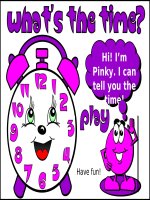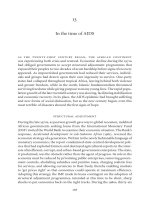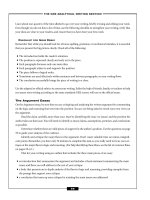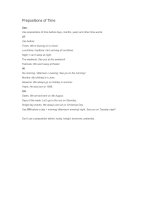29708 telling the time prepositions of time
Bạn đang xem bản rút gọn của tài liệu. Xem và tải ngay bản đầy đủ của tài liệu tại đây (85.7 KB, 3 trang )
What's the Time ?
There are two common ways of telling the time:
•
Formal but easier way:
Say the hours first and then the minutes:
Example: 7:45 - seven forty-five
•
More popular way:
Say the minutes first and then the hours.
In English we use o'clock only to say full hours / round.
Example:
6:00 It's six o'clock.
7:00 It's seven o'clock.
8:00 It's eight o'clock.
8:01 It's one past eight. (In this case we no longer say o’clock)
We use "PAST" to say the minutes until the limit of half an hour.
Examples:
6:10 pm. It's ten past six.
12:15 pm. It's quarter past twelve.
4:25 pm. It's twenty-five past four.
2:28 pm. It's twenty-eight past two.
10:30 am. It's half past ten.
We use “TO” to tell the time from 31 minutes to be completed before a full
hour.
Example:
2:35. It’s twenty-five to three.
6:40. I’ts twenty to seven.
9:45. It's quarter to ten.
7:55. It's five to eight.
•
American English
Beside past, Americans often use after.
Example: 06:10 – It’s ten past six./It’s ten after six
But in time expressions with “half past” it is not usual to
replace “past” by “after”.
Beside “TO” Americans often use “before”, of or “till”.
Example: 05:50 – It’s ten to six/ It’s ten before/ It’s ten of six/ It’s ten till six.
Prepositions of time
We use:
• at for a PRECISE TIME
• on for DAYS and DATES
AT
precise time
ON
Days and dates
at 3 o'clock
on Sunday
at 10.30am
on Tuesdays
at noon
on 6 March
at dinnertime
on 25 Dec. 2010
at bedtime
on Christmas Day
at sunrise
on Independence Day
at sunset
on my birthday
at the moment on New Year's Eve
Look at these examples:
•
•
•
•
•
•
I have a
meeting at 9am.
The shop
closes at midnight.
Jane went
home at lunchtime.
Do you
work on Mondays?
Her birthday is on 20
November.
Where will you
be on New Year's Day?









